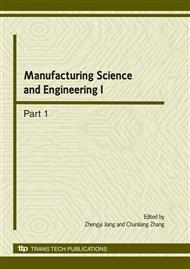p.1077
p.1083
p.1087
p.1091
p.1097
p.1104
p.1109
p.1116
p.1120
Tribological Behavior of Ti(C, N)-Based and Functionally Gradient Ti(C, N)-Based Cermets
Abstract:
Ti(C, N)-based cermet and functionally gradient Ti(C, N)-based cermet were prepared by vacuum sintering and post surface heat-treatment in nitrogen, respectively. Tribological behaviors of obtained cermets were comparatively studied. Dry sliding wear and cutting test were conducted against quenched medium carbon steel. It was found that a graded structure formed and the surface hardness of functionally gradient Ti(C, N)-based cermet was improved. Friction coefficients of both cermets decreased with the increase of the sliding speed. The friction coefficient of Ti(C, N)-based cermet was lower than that of functionally gradient Ti(C, N)-based cermet at the conditions of higher sliding speed and higher load. The cutting test demonstrated that Ti(C, N)-based cermet exhibited better cutting performance and higher wear resistance than the cemented carbide YT15, cermet TN20 and functionally gradient Ti(C, N)-based cermet, while the functionally gradient Ti(C, N)-based cermet exhibited a similar performance as YT15 and TN20.
Info:
Periodical:
Pages:
1097-1103
Citation:
Online since:
March 2010
Authors:
Price:
Сopyright:
© 2010 Trans Tech Publications Ltd. All Rights Reserved
Share:
Citation:


